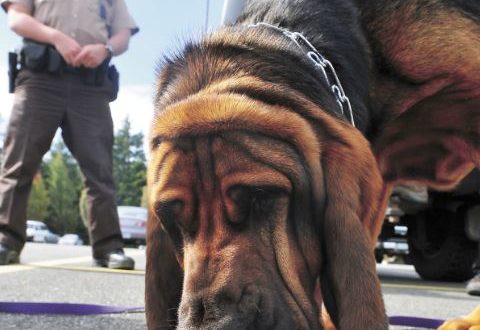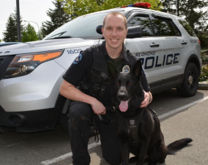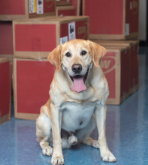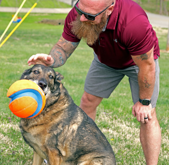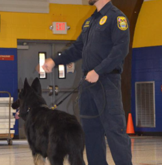Died 11/10/16
Handler – Edward Makaruk
Franklyn the blood hound dies
Dog helped solve local murders, find missing persons, and even missing cars
Franklyn the bloodhound took his last trail home Nov. 10. His trainer, Edward Makaruk, remembered him this week as he prepares to bury Franklyn’s ashes. Franklyn not only worked for the Coos County Sheriff’s Office, California Oregon Regional Search and Rescue, and the Oregon State Sheriff’s Search and Rescue, but entertained crowds at the Farmer’s Market and visited students in local schools. “Everybody knew him,” Makaruk said. “Everybody loved him.”Makaruk was surprised to find himself training rescue and law enforcement dogs since he had never done it before until he was visited by Coos County Sheriff’s deputies at his house. “Twenty years ago, the cops came to my place to talk to me,” he said. “I had my dog trained that when people came to the door, she stayed back and sat. The deputies loved it and one of them called me to see if I would train Franklyn. I was a natural.” At first Makaruk didn’t want to take in another dog because the one he had was a German Shephard and already sick and dying. Franklyn was 8 months old at the time when Makaruk was asked to take him in, having been a show dog that was no longer being shown and had no place else to go. “I had wanted to take him in long enough to find him a home, but when the deputy called me to see if I would train him, well, he stayed,” Makaruk said. Makaruk was trained first and went through two levels with the American Society Trainers, studied with the Indiana Department of Corrections that specialize in blood hounds, and later trained with 832 Deputy Dogs out of Florida. “When I started training Franklyn for Search and Rescue, we found a 4-year-old autistic boy and it was like crack, we just had to keep finding people to save,” Makaruk said. “We later found a lady in Hauser that went down in the bushes. He worked on murders, worked on the case where a guy stole a North Bend Police car. Franklyn tracked it to Lakeside, tracked it all the way to the house. He was learning 24-hour hold treads in the rain. Bloodhounds are the most phenomenal sensing dogs. There’s nothing even close to being as good as them.” Makaruk also studied with the FBI where he learned that dogs turn their heads to read the sides of people’s faces and read their “electrical energy,” and that they can even discriminate someone’s odor off exploded shells and mortars. Franklyn also did his own show at the summer Farmer’s Market where Makaruk would place a hot dog on Franklyn’s foot and make him sit with it laying there until he was told to move. “People would watch and just loved him,” he said. “You’d have to look through a thousand dogs to find that temperament.” But in 2012, Franklyn was injured and had to be retired. “We held a party for him and he ate a cake,” Makaruk laughed. “But he was still used to train other dogs, and really never retired because I used him to find missing kids or missing mushroom pickers.” Franklyn helped train the new dogs Makaruk was asked to prepare for the workforce. “Young dogs learn better from each other than you and me,” he said. “They would see him in his harness and they would learn.” Franklyn and Makaruk trained three dogs together. There was Freddy, who went on to work in the Sterns County Sheriff’s Office; Angel, who went on to the New York City Police Department’s emergency and service unit; and Aspen, who works with the local emergency and response teams.“We were going to train another together, a puppy being sent to us in March,” Makaruk said. “I was going to name him Argo after Cape Arago. I like the two syllables because that’s the sound of a command. Argo is already sold, but I’m not allowed to know to who, which means the FBI or some other federal agency.” But long before Argo arrived, Makaruk’s girlfriend found a tumor on Franklyn’s neck. It would have cost $2,000 to take it out, and his back was already going bad since life as a working dog usually takes a toll. “I thought that if he makes it to the Farmer’s Market to get his hot dog, I would wait,” Makaruk said. “He did, he made it, and got his hot dog, but then one morning he woke up and his tumor was the size of a softball. He wouldn’t get off the couch and I knew he wanted to go home. I wasn’t going to let him suffer, not after everything he’s done.” Makaruk put him to sleep Nov. 10. “I had a good cry, but you have to be happy for him,” he said. “He’s helped train dogs, and the work he did will continue and continue. That’s a good feeling for me.”
